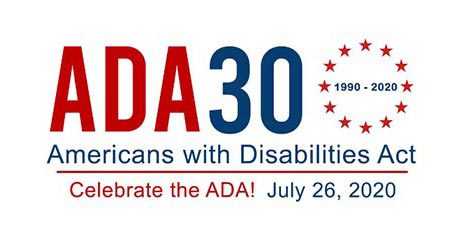The Americans With Disabilities Act (ADA) turned 30 years old on July 26, 2020. Originally signed into law in 1990 by President George H.W. Bush, this was a landmark piece of legislation that expanded civil rights for individuals with disabilities similar to those provided on the basis of sex, race, color, age, national origin, and religion. Specifically, this law prohibits discrimination on the basis of disability in employment, state and local government, public accommodations, transportation, and telecommunications.
This law did not come about passively. It took decades of advocacy from disability rights activists to bring the ADA to fruition. One protest in March of 1990 even included individuals with physical disabilities abandoning their wheelchairs and crawling up the steps of the US Capitol building—an event now known as the “Capitol Crawl.” After centuries of poor treatment and discrimination, American citizens with disabilities were finally recognized as equal citizens under the law.
Accessibility is a civil right

Across all its domains, the ADA essentially designated accessibility as a civil right, not only for people with disabilities, but for anyone. Accessibility is the ability for any individual to access or benefit from a system or entity. It paves the way for people with disabilities to have equal access to the same goods and services in their community as nondisabled individuals. It does not end with being able to access a physical space either—there are many ways the Americans With Disabilities Act ensures accessibility.
For example, a doctor’s office’s building could have a ramp in addition to stairs, and a push button on the door for easy access inside. Once inside the doctor’s office, the receptionists’ desk could be lowered so that someone in a wheelchair or a person of short stature could easily fill out their paperwork. The paperwork can be provided in large print or braille for individuals who have vision limitations. An American Sign Language interpreter should be provided if the patient is Deaf or hard of hearing. The exam rooms can be equipped with exam tables that can be lowered to allow for easy transfer onto and off the table. As this example demonstrates, it’s not enough to simply get inside the building—the ADA ensures that all the services and policies inside the building are accessible as well.
Protections under the Americans With Disabilities Act
The Americans With Disabilities Act considers an individual to have a disability under three criteria:
- The person has a physical or mental impairment that substantially limits one or more major life activities,
- The person has a record of such an impairment, or
- The person is regarded as having such an impairment.
The first criterion addresses those whose disability clearly creates significant limitations for activities such as hearing, speaking, walking, breathing, learning, or caring for oneself. This definition is broad – it includes physical disabilities (e.g., paralysis, chronic pain), cognitive disabilities (e.g., traumatic brain injury), sensory disabilities (e.g., deafness, blindness), as well as developmental disabilities (e.g., Autism, intellectual disabilities). It also includes mental illnesses such as schizophrenia, bipolar disorders, or major depressive disorders.
The ADA also protects individuals from being discriminated against if they have a record of such impairments. For example, if an individual has undergone treatment for cancer and then returns to work, they cannot be discriminated against for their cancer diagnosis. Although their cancer may be in remission, their previous diagnosis of cancer provides a record of them having had it.
The last criterion protects any individual who is assumed to have a disability. This could include conditions that do not substantially limit any major life activities, or those who have an impairment that limits major life activities only as a result of others’ attitudes toward them. For example, an individual who is a burn survivor may have multiple facial scars that do not impact any major life activities, but cause others to discriminate against them or assume that they cannot perform certain tasks.
While many Americans may not consider the ADA to be specifically applicable to them, the truth is that the ADA will protect you at some point in your life. Whether your leg is broken and you require a wheelchair and curb cuts in the sidewalk, or you acquire a medical condition that impacts a major life activity, the ADA protects your civil rights during these times. Additionally, the majority of disabilities are acquired later in life, affecting 35.2% of individuals over the age of 65 as compared to 10.6% of individuals ages 18 to 64, and only 6.3% of children under age 17. If you live long enough, you will likely experience some type of disability or a condition that would be considered a disability under the ADA—and this law will protect you.
Looking back to the past
The passing of the Americans With Disabilities Act is one of the most critical elements in the history of disability rights in the U.S. It is one of the world’s most comprehensive pieces of civil rights legislation, affecting nearly 40 million Americans and dramatically expanding the rights of people with disabilities in all walks of life to be included, supported, and empowered. Playgrounds, public transportation, voting, and retail stores were all effected by the law and required accommodations and accessibility for disabled individuals.
Prior to the ADA’s passing, civil liberties for people with disabilities in public spaces were sparse, and protections were piecemeal. While prior laws like Section 504 of the Rehabilitation Act prevented discrimination in federal places and policies, it was still common for disabled individuals to be discriminated against in public spaces. An individual with a wheelchair could be denied entry into a movie theater. A person with cerebral palsy could be asked to leave a restaurant if their appearance or voice made other patrons uncomfortable. An employer could have openly refused to hire an individual with Autism, a physical disability, or a pre-existing medical condition. Now, under the ADA, it’s difficult to imagine these injustices taking place so frequently, and with no legal recourse.
The future of the Americans With Disabilities Act and “Generation ADA”
Now, 30 years later, there has been a new era of people with disabilities who have grown up with the ADA and its protections as a birthright. Known as Generation ADA, these young individuals expect the law to guarantee protections in employment, education, transportation, and public accommodations. This generation has also shifted perceptions of disability in general – more members of Generation ADA are quick to claim disability as a critical part of their identity, and to claim “disability pride” in rejection of the stigmas placed upon being disabled in American culture.
However, there are still hurdles for disabled individuals when claiming full participation in society. While the ADA drastically improved access to employment, there are still large employment and education gaps between disabled and nondisabled individuals. The employment-to-population ratio of people without disabilities in 2018 was 77.8%, while the ratio for people with disabilities was 37.5%. Disabled workers earn significantly less than nondisabled workers and are more likely to live in poverty. There is also a large gap in education, with less disabled students graduating high school or attaining a college degree.
Other disparities continue to persist – especially as the coronavirus impacts this year’s ADA anniversary. People with disabilities are facing huge inequities in access to healthcare and are at a greater risk for contracting and dying from COVID-19. Recent concerns over triage practices that discriminate against people with disabilities from receiving life-saving care for COVID-19 has also prompted the Office for Civil Rights to issue a bulletin reminding hospitals they cannot use disability as a reason to deny treatment.
While discrimination continues to persist, disabled people and Generation ADA have much to look forward to. Progress will continue as more young people become part of the disability rights movement and continue to demand equal participation in society. Leaders with and without disabilities have begun to recognize the impact of the ADA in every American’s life, and will continue to proclaim “nothing about us without us” as future pieces of legislation are created. There is so much that has been accomplished, and so much further to go. But, for what progress has been made these last 30 years, we can all be grateful for what the ADA has given us.

Relias Underwrites National Television Broadcast of Hearts of Glass Documentary
Relias is one of the major underwriters of the national public television broadcast of Hearts of Glass, an award-winning documentary about inclusive employment for people with disabilities. Learn more about the impact of the ADA on the inclusion of people with disabilities in their communities.
Read the Press Release →





